by Andrew Morrison
Have you caught the bug? Are you interested in building a tiny house? If so, I suggest you attend a hands-on workshop to learn how to do it right before you jump into your own project. In line with that, I have a great opportunity for you, but first, I want to talk a little bit about the insanity of living in a large home.
There is no question that we, especially here in America, have built our houses too big in†the†last 50 years. The last 20 years especially have been the worst in terms of super sizing our homes. We have gone over the deep end and for some reason, we continue to build houses that have enough space to shelter 30 people and yet only 2 or 3 actually live in them. The amount of resources necessary to build and maintain these homes is immense and the impacts, both environmentally and financially, are huge. You’ll likely be shocked to know just how much each hour you spend awake in your home actually costs!
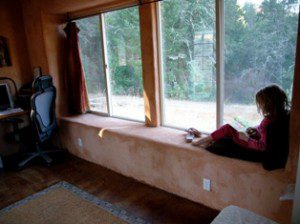 If you are like most Americans these days, you are feeling the pinch of the American Dream. Maybe you have the dream house, but you are suddenly realizing†that it isn’t really a dream after all but more of an extended financial nightmare. Many Americans†struggle everyday just to make their mortgage payments. In fact, financial institutions filed 3.8 million foreclosures in 2011 alone according to ReatlyTrac, an on-line company that tracks foreclosures in the US. That’s 3.8 Million foreclosures in one year!
If you are like most Americans these days, you are feeling the pinch of the American Dream. Maybe you have the dream house, but you are suddenly realizing†that it isn’t really a dream after all but more of an extended financial nightmare. Many Americans†struggle everyday just to make their mortgage payments. In fact, financial institutions filed 3.8 million foreclosures in 2011 alone according to ReatlyTrac, an on-line company that tracks foreclosures in the US. That’s 3.8 Million foreclosures in one year!
I know there are many reasons for the foreclosures, but I would be willing to bet (and I’m not a betting man) that many of them were the result of people being in over their head with financial commitments to their lender. Why? Because these McMansions have put such a strain on their owner’s wallets that eventually, the wallet breaks and down goes another home to the foreclosure pit.
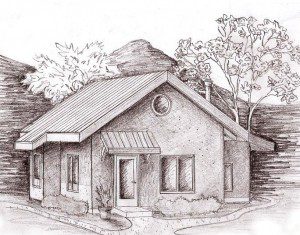 Now, what if you could build a beautiful, 200SF tiny home for $8,000? Perhaps you need something bigger. No problem. What about a 570 SF home for around $30,000? That’s less than most people’s down payments on their homes. That means that most of the people who have recently lost their homes could actually have paid cash for a tiny home. I bet our foreclosure rates would be much smaller if more people had taken this route. By the way, smaller does not have to be ugly or cramped. With proper design, a tiny home can be beautiful and completely†functional.
Now, what if you could build a beautiful, 200SF tiny home for $8,000? Perhaps you need something bigger. No problem. What about a 570 SF home for around $30,000? That’s less than most people’s down payments on their homes. That means that most of the people who have recently lost their homes could actually have paid cash for a tiny home. I bet our foreclosure rates would be much smaller if more people had taken this route. By the way, smaller does not have to be ugly or cramped. With proper design, a tiny home can be beautiful and completely†functional.
Here’s the reality of how “useful” a big home is. I’m going to make some assumptions about how people spend their day and I recognize the lack of scientific data this presents. Bear with me. Most people work outside of the home from 9-5, not including their commute which I will assume is 1 hour each way. That means they spend an average of 10 hours a day away from their home. If they get home at 6pm, they likely eat dinner, watch some tv (don’t even get me started on that topic) and then go to sleep at 10pm or so. The next day, it all starts over again when they wake up at say 7am to get ready for work.
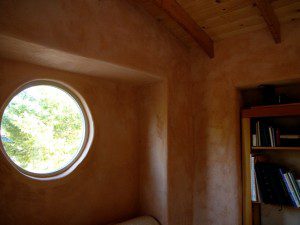
Let’s do the math…10 hours away from the home + 9 hours sleeping = 5 hours of time actually spent awake in the home. If we assume that with the “extras” of daily life: running†kids around to games and friends houses, food shopping, going out to movies, etc.. that folks get an additional 5 hours in the home each of the two weekend days. That gives us a total of 35 hours per week in the home. Assuming a $250,000 mortgage ($1655 monthly payment), each of those “awake hours” would cost just shy of $12 to pay for the mortgage†over thirty years. That does not include any utility costs or†maintenance, just the mortgage. Over 30 years, that’s a lot of money: $595,638!
From this perspective, can you imagine one reason why a 5000SF or even 2000SF house is necessary? Of the 35 hours per week that you are actually awake in your home, you probably spend 3 hours of that cleaning the place. The more you do this math, the crazier it all gets. I would much prefer to have a house that fits my needs, is super efficient to maintain and clean, and that I own outright. It’s time to get real: what do you REALLY need out of your home?
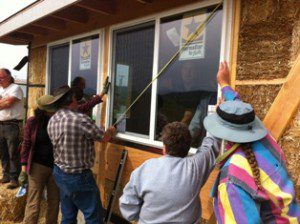
My daughter just brought up a really good point when I asked this question out loud. She said that people want a big home because it makes a statement. It says they are successful. It’s amazing what wisdom our children have. So, you can choose:
- Option number 1: You can have the image of success and live in the struggle of financial stress.
- Option Number 2: You can have financial success and live without the struggle or stress of expensive housing.
The choice is yours. It takes a certain courage to live outside of the box that our society has said we should strive for; however, I don’t think the pain of living in that box, simply to please others and satisfy the “right image,” is worth it. I’d rather be happy.
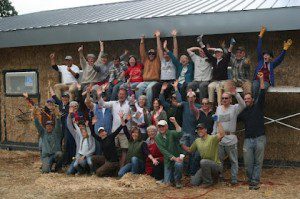
Okay, I said I had a great opportunity for you and I do. I will be teaching a two-week, hands-on workshop in Jacksonville, Oregon this September 10-23, 2012 on how to build a tiny home. We will actually be building two tiny straw bale cabins for a couple in the beautiful Oregon countryside. The class will cover everything from forming and pouring the foundations to framing, baling, electrical, plumbing, and plaster. We will cover it all!
This is an awesome opportunity for you to learn how to build a tiny home under expert guidance and in a community-based building†environment/experience. The class itself will be a lot of fun and we will have a day or two off to explore the area and enjoy beautiful Southern Oregon. If you are interested in learning how to build either a straw bale house or a tiny house, this workshop will be perfect for both interests.
Click here to learn more about the workshop or to sign up for the class (space is limited and I only have 5 more spots available). The reality of the class is slightly different than the posted description on this link because we have added a second 200SF cottage to the class.
We have a special offer just for our Tiny House Blog friends. To learn more about that offer, please email us directly at info@strawbale.com. It’s well worth the email!
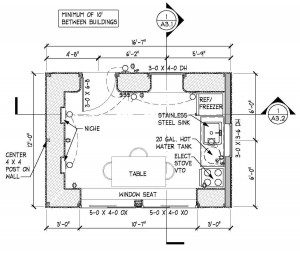 In case you’re wondering what the cabins will look like, I have included the floor plans here for you to review. What’s great about these cabins, is that they will truly be something one could live in. They will have a kitchen, bedroom, bathroom, and living area. Although small, they are perfectly suited for comfortable living while also being natural and super efficient. Sure you can cram a lot more into a building with thinner walls, but this one will keep you comfortable all year long, whether it’s cold or hot outside and all with minimal need for heating or cooling. The climate will take care of it for you: passive heat and passive cooling. I know it’s hard to see the details on these drawings, so click on the images to see a larger version.
In case you’re wondering what the cabins will look like, I have included the floor plans here for you to review. What’s great about these cabins, is that they will truly be something one could live in. They will have a kitchen, bedroom, bathroom, and living area. Although small, they are perfectly suited for comfortable living while also being natural and super efficient. Sure you can cram a lot more into a building with thinner walls, but this one will keep you comfortable all year long, whether it’s cold or hot outside and all with minimal need for heating or cooling. The climate will take care of it for you: passive heat and passive cooling. I know it’s hard to see the details on these drawings, so click on the images to see a larger version.


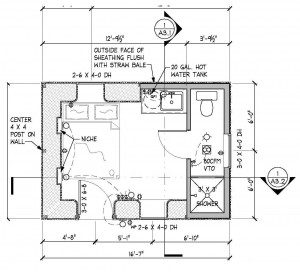
Great arguments in favor a smaller houses. We certainly agree that small houses can be functional and beautiful!
– Mili
Option number 1: You can have the image of success and live in the struggle of financial stress.
Option Number 2: You can have financial success and live without the struggle or stress of expensive housing.
Well spoken! I will never go back to a big house, I will never ask my mate to sacrifice himself to provide me with a big house, and all the things needed to fill it. If I am not willing to make myself a slave, how could I ask that of another?
Thank you for this post.
Your $8k and $30k figures forget the cost of land.
Some municipalities have minimum house sizes. Locally the smallest you can build is 1,000 sq ft.
Otherwise you are correct. North American homes are way too large.
A house should be a home, not a debtor’s prison.
Indeed, the cost of land has to be figured into any equation when building; however, there are so many variables in pricing it is impossible for me to put a number on it. A mention would have been a good idea though.
The minimum square footage is a problem in my mind. This is something that we need to address as a nation. Do we really want to tell people to build green, save the environment, and then force them to build a house that’s bigger than they need? Seems wrong to me. I imagine they are trying to protect home values, but a tiny home can be a beautiful, elegant, amazing home. If that’s their worry, perhaps they should regulate quality, not quantity.
Nice houses.
I hope these are to code and that people do their homework regarding local regulations.
I enjoyed the article. We built our “dream home” 25 years ago and it was paid for over ten years ago. The biggest problem: our “dream home” is an hour’s drive from all medical folks and hospitals. We’re in our late 60’s and it’s also WAY too much house to clean. If we’re lucky enough to build another house, you can bet it will be as small as the zoning allows!
Absolutely fascinating and maybe it is time to stop lusting after a bigger home. Being from the UK, I think our homes are generally smaller. At least, I am always taken aback when I see TV shows with huge American homes. I wonder how the average home size compares on either side of the Atlantic.
Absolutely, I think the ‘image of success’ plays a huge part in a person’s desire for a large home.
I have always been a big fan of houses like these. Tiny houses are way too good. No or very little maintenance so there is no headache either. I will definetly build a tiny house one day. The pictures you showed of the tiny house looks awesome.
Kind of stretches the meaning of ‘houses’. From the drawings it appears one ‘house’ is a bedroom/bath and the other ‘house’ is a living room/kitchen.
Without the straw bales around the bathroom wouldn’t it be a cold place to go in the middle of the night?
Why not swap the shower and toilet so the shower will be closer to the water heater?
Benjamin, You raise a good point about these being a bit of a stretch to be called “a home” in and of themselves. The spaces could indeed be used as a home if configured differently and made a bit taller. The advantage of doing them this way is that the structures fit the requirements for not requiring a building permit (under 10′ tall and less than 200SF).
The bathroom won’t be cold because it will be insulated to standard housing requirements of R-21. It will be less efficient than the main portion, yes, but not cold.
Great idea about the shower and toilet switching spots. Not sure why we didn’t think of that one. We will certainly do it that way unless the owner has a specific reason for having placed it as he has.
It seems the 8k and 30k number would be for materials expenses… but if you haven’t built a house before, be prepared to accept how MUCH time you will put in as labor. Experienced builders might take 4-6mo fulltime labor (one person) to get a tiny house from trailer frame to trimwork. This may be less if you use alot of out of the box building materials and more conventional techniques.
Just sayin’. Everything good takes its time…
Let me first say, I am a BIG fan of the tiny house movement and we’re actually building a 384 sq ft cabin on our off-the-grid land and we’re moving there to live for a year for the experience.
But I currently live in a 5100 sq ft house and yes it’s quite pricey to maintain. But it’s my choice to live like that. Demonizing other people’s choices when they don’t match your own desires, isn’t really the best solution for recruiting others to the tiny house movement. You can point out the downsides, that’s fine and should be done as there are lots of downsides to living in a big home. And yes, I realize we’ll save $80K a year by moving to a small home, off the grid. I get that. But please don’t elevate your choices of living simpler by telling those that don’t choose that, that they’re making the wrong choice and there’s somehow a moral imperative that they not “waste” so much resources. That’s when you lose people like me who think it’s really cool that one can live simple and people choose to do that…etc. But it’s just a choice and no better of one than someone else’s choice. You’re not somehow holier or a better person because you choose to live in a smaller home. That’s just nonsense. And you may not mean to say that, but the tone of your post leads people to that conclusion.
I greatly admire those that can live in a small home and indeed, I’m going to do it for a year, too. Can’t wait, actually. But I’ll be going back to my larger home not because it’s a status symbol but because I like my kids being able to bring people over and enjoying the pool and the huge play areas. I like having 30 people over and everyone can enjoy themselves in comfort. If I’m evil because of that… well, I guess I’m evil.
Incidentally, we moved away from Oregon to get away from this kind of judgmental attitude. I’ll call them the “Birkenstock” crowd. Tolerant until someone doesn’t agree with them, then it gets personal and the other party is “evil” or somehow lessor of a human being because they don’t agree with them. 🙁
Cheers!
Hi Dan. Thanks for your comment. I in no way meant to offend you or suggest that I am better than you because of the size house you live in. I totally understand that some people choose a larger house for specific reasons and, yes, it is their choice to make. That said, the average home size in the US is bigger than it need be. Not everyone entertains 30 people regularly. I just moved to Colorado and when we looked for a home rental, we literally could barely find anything under 4000SF. I should note that the majority of people who live here (Colorado Springs) have some tie to the military and typically have two adults and MAYBE a young child or two. There is no reason why they would all need such large homes. In fact, I have not seen any of my neighbors in the month that I’ve been here even have one person over to entertain. They wake up, go to work, come home and go to bed: day after day. I’m not saying they are evil, just stuck in a system that our culture has created: a belief that “large houses are better.” If it is a conscious choice and you have specific reasons for living in a large home, that’s fine; however, for those who don’t even think about it and just live in a huge home that they don’t use, I think they (we all) need to wake up. We live in a world of finite resources, like it or not. We don’t have all the trees we need to build such big houses, nor do we have the fuels to heat and cool them. It is wasteful, and I don’t think that is a judgment of character as much as it is a fact of reality. Air conditioning a 4000 SF home for 2-4 people is wasteful. I’m sorry if I lost you or others in the conversation because of my approach to this topic; however, I am truly trying to point out the craziness of how many of us live. I say us, because I live in a rental house here that is far bigger than I want. It’s the best I could find for our needs. We don’t use our AC unless we simply can’t bare the heat, and we conserve in every way we can. That said, it’s no tiny house, that’s for sure! So even when someone WANTS to live tiny, our society does not allow it. That’s teh problem. There are areas with minimum home sizes as Tom pointed out and the “spec houses” get bigger every year. If spec houses were built smaller, people would likely be just as happy. Finally, it’s about design. If you like to entertain 30 people at a time, that’s awesome; however, I still don’t think you need 5000 SF to do that. I would venture a guess that your master suite is big enough to hold a party in and that the kitchen is too. The secondary bedrooms are probably bigger than they need to be as well. It’s the way builders build these days. Why? Our master bedroom in our old house was so big that we had a king size bed, a fireplace, two dressers, a plant and still had room to hang out comfortably with 8 people. That’s nuts…it’s a bedroom. Anyway, I appreciate your point of view and I understand where you are coming from. I just think that our society has blinded us to what we really need, whether it’s enough space to entertain 30 or simply to live as a family of 4.
I lived gracefully in 325 square ft for well over a decade and regularly had wonderful parties even in the winter with at least 20 often 25 people over. What makes a house good for gatherings is much less about size than it is about design. In my new 1000 sq ft house which feels like a mansion I took a small living room that sat 5 people and wrapped it in modern minimalist couches wall to wall and had 24 people comfortably seated and chatting at my anual Chinese New Year Party and there were another 10 hanging in the adjoining kitchen. It’s all in the design, I went into a clients 3 story 10 bedroom house the other day that I would feel very hard pressed to hold a party in. Size really doesn’t matter.
The issue of land has already been brought up but I was wondering if you’ve done a write-up dedicated to that aspect of a tiny home. A tiny home is ideal for me but where would I be able to build one is the question.
I’m really sorry that Dan was offended by the article and the discussion. I caught his point about choices and I also see the fundamental differences between the two points of view, most notably that the author speaks of NEED and Dan speaks of WANT. I also love to entertain, and when I do it’s generally more than 30 people. That said, my home is 1,200 sq ft and we do it in the yard with awnings, patio heaters as needed, on the front porch, and then the main floor of the house.
One point that I hope Dan will be able to fully get, as it is not intended to offend nor maybe even to sway, but just to fully share a perspective. I’m willing to bet his 5,100 square foot house is modern and ridiculously well insulated and sealed (in spite of my many efforts to insulate and seal my old home, people with much larger newer homes pay less to heat and cool them, but I justify it because mine will stand up to storms and centuries more because of the way it’s built) and all of that said I just want to share this:
Whatever we choose to use, own, and keep to ourselves is something that others cannot use, own, or keep to themselves. When we heat that much space, there is less gas or electric for others. When we overeat there is that much less food for someone else. If we choose to drive a vehicle that uses 12 or 16 mpg, that fuel is not available to someone else and may have incurred some human costs to procure. If we waste any resource, the demand is that much higher and forces others to pay a higher price as a result. If Dan sells his large home, someone else will buy it and live in it. Getting him to downsize will not make a real difference, but if hundreds of thousands of Dans sell their homes, builders may be swayed to build the things that Dan now wants (in our example). If we who wish to save resources want anything to change, it must be a cultural change, and as Dan said, demonizing or even patronizing others because of their choices will only steel them against change. I wish us all well in the coming decades, because I now believe our choices and the choices of our culture are no longer sustainable. Either we will make the choices or the market and the rest of the world will make them for us.
I agree that it is a great argument for building a smaller house. One of the many benefits of building, or having your own home built is that you can customize the size as well as many other features.
@eric – cheers! Use what you need people – I have a friend who’s mom is divorced, has one kid (who is grown and lives on his own), never has people over and lives in a 12-room mini-mansion – just because she can? I guess? there are rooms in that house that have yet to be furnished! I mean, three guest rooms alone…it’s crazy. And she probably only uses a fraction of the space in that house.
Really good points you make Kent. There is a movement in many capital cities around towards smaller lot sizes. I think into the future this trend will continue and the growth of smaller house sizes should continue, partly due to expanding population and land constraints. It’s also a more efficient space which enhances sustainability for future generations.